The real estate market replicates commodity, not community
I swear earlier in the year I read a piece by the economist John Kay, where he made the point that capitalism isn't so much about the purity of the unseen hand and market forces, rather that the market replicates things that are good at replicating. (I can't find it now.)
This piece from the Boston Globe (found via the Progressive Review) "Last call: Why the gay bars of Boston are disappearing, and what it says about the future of city life," discusses the loss of "third places" and the kinds of amenities that make city life attractive.
From the article:
But as a wide range of gay bars dwindles to a handful of survivors - and the city's diners, indie bookstores, and dive bars yield to high rents and shifting patterns of commerce - that air is becoming the province of an increasingly narrow set of people....
Businesses like bookstores, video stores, and gay bars can no longer afford to occupy valuable real estate when their goods or services are more easily and cheaply delivered electronically. As these businesses disappear from Boston streets, they're usually replaced by more profitable land uses, such as office towers and high-end restaurants. The result is a variant of the "tragedy of the commons": Hotels, condo complexes, and other upscale businesses market themselves as part of a vibrant city, but they can also make it more difficult to maintain that vibrancy. (The ground floors of new office and housing buildings are often reserved for retail use, but CVS and other chain stores usually snap up the space.) These high-end businesses attract new residents and consumers to urban neighborhoods, but when they aren't balanced by other types of economic activity, the result can be a sterile streetscape rather than a diverse ecosystem.
There are many factors going on here. While I am not sure I fully agree with the author's conclusions, there is no question that as cities again become high demand places, less profitable uses get crowded out, and the city becomes less interesting and more placeless.
Downtown DC is a perfect example of this, as the last truly original independent restaurant downtown, Waffle Shop, gets deconstructed and removed from its location on 10th Street NW and relocated to 6th Street and New York Avenue NW.
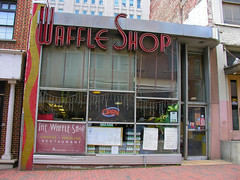
Flickr photo by Otavio DC.
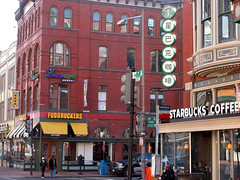
Flickr photo by Kennedy Smith.
In fact, when I first came to DC I didn't understand why for the most part there weren't diners and the other kinds of places I associated with city life, why was it that McDonald's seemed to be the largest purveyor of breakfast in the city?
This is related to a comment I made yesterday at Chris Leinberger's talk. The Brookings Institution released the results of a study on walkable urbanism, including the point that about 1/3 of the market wants it, 1/3 doesn't, and 1/3 doesn't care either way, but in any case, there isn't enough "product" (not their word) to satisfy the present and latent demand. See the AP story "Wash. Leads Metro Areas in Walkability" and the study, Footloose and Fancy Free: A Field Survey of Walkable Urban Places in the Top 30 U.S. Metropolitan Areas.
Some colleagues were taken aback by the study, because many places that we know are walkable aren't listed. This is so for at least two reasons.
First, they focused on places that provide regionally attractive retail and commercial space. This knocks out many places like Capitol Hill or Cleveland Park because for the most part they are neighborhood serving (I know that Cleveland Park with a theater and restaurants is a kind of {"regional" destination for Ward 3 neighborhoods but the general point remains.)
Second, they focused on places that have the potential for adding a great amount of infill construction of housing, retail, and office, and/or with the potential for redevelopment. This means that places like NoMa rated highly, and neighborhoods like Capitol Hill or Cleveland Park wouldn't qualify.
Professor Leinberger is known for a classic paper, "The Need for Alternatives to the Nineteen Standard Real Estate Product Types," from Places Journal, about the standardization of the primary real estate products produced by developers--product types oriented to the suburbs, not traditional center cities and more urbanized, walkable places. From the standpoint of political economy, this explains the commodification (as well as the systematization of real estate development around regionally, nationallly, and internationally significant actors as opposed to small, local one-off or otherwise small developers) of the industry, especially around financing.
His new book is about rebuilding the development system for walkable places, and he spent a lot of time in his presentation yesterday showing how suburban land use practices were optimized and subsidized, but also the demand for urban living, and the primary land use development product types for the future:
1. Downtowns (Central Business Districts)
2. Downtown adjacent (places like Dupont Circle)
3. Suburban Town Centers (Bethesda)
4. Suburban redevelopment (Ballston, Friendship Heights)
5. Suburban greenfield (Reston)
The problem is that this revitalization will be led by developers, and their motivation isn't creating walkable interesting places, but about profit maximization. They will invest in building quality places so long as the marginal returns are positive.
And the problem with reproducing these spaces is that small buildings get demolished and the land assembled into plots for superbuildings, and superbuildings beget superblocks. Superblocks are anti-pedestrian.
Arlington is the big example of success in this realm. Arlington has been successful with transit oriented development.
But I think we can agree, despite their best efforts, that the quality of the space in terms of the experience, is more akin to downtown DC than it is to Dupont Circle. The one major exception is Clarendon, because of the small number of traditional buildings that still exist, and the uses that populate these buildings such as Clarendon Ballroom and cool restaurants. On the other hand, much of Clarendon is being reproduced into "urban lifestyle center" real estate product rented to national chains.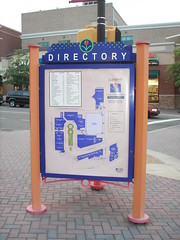
Directory for Market Commons, an infill "lifestyle center" with chain retail (and across the street from a Cheesecake Factory.)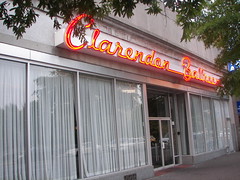
And Ballston and Virginia Square and Courthouse and Rosslyn aren't necessarily great places for walkability and interestingness.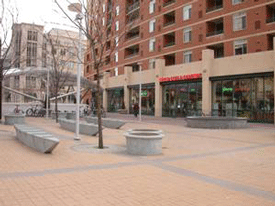
Virginia Square Metro entrance. Arlington County photo.
It's enough to want to make me go out and immediately read David Harvey and Henri Lefebvre...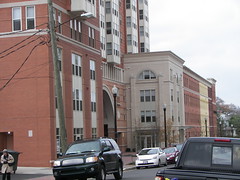
Northern edge, side street, Clarendon
Labels: intensification of land use, mixed use, urban design/placemaking, urban history, urban renewal, urban revitalization, urban sociology



0 Comments:
Post a Comment
<< Home